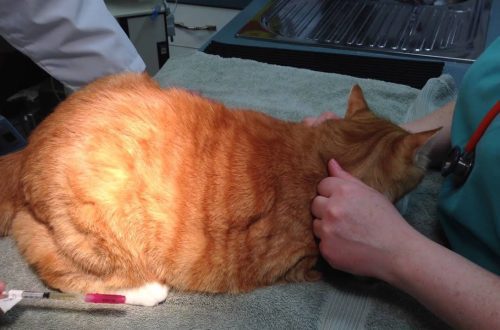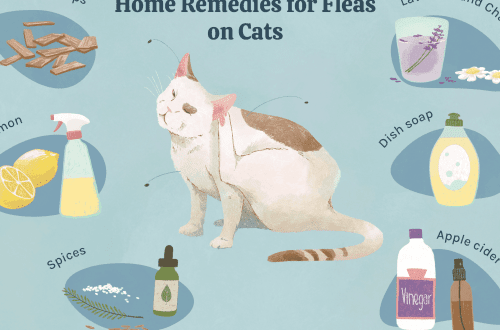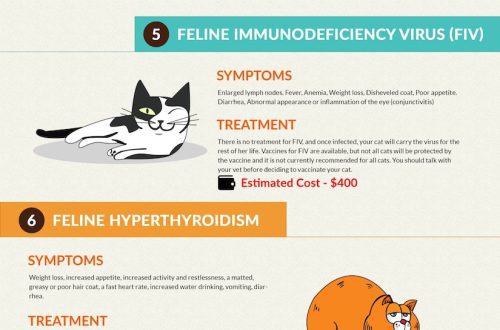
Worms in cats: signs and treatment

Contents
- Types of worms in cats and what they look like
- Nematodes in cats
- Cestodes – tapeworms in cats
- Trematodes in cats
- How does the infection occur?
- Symptoms of worms in cats
- Diagnostics
- Treatment of worms in cats
- Worms in kittens
- Prevention
- Can you get worms from a cat?
- Helminths in Cats: Essentials
- Answers to frequently asked questions
Types of worms in cats and what they look like
Nematodes in cats
Nematodes are roundworms. They have a round body in cross section. White, long, with pointed ends. Nematodes include parasitic and free-living worms.
Cats are parasitized by the following species.
Toxocara (ascarid)
Males reach 6-7 cm in length, females – up to 10 cm.
They are parasitic worms in cats and other members of the feline family.
The development cycle is very complex: once in the intestines, toxocara begins to migrate through the bloodstream to the liver, lungs, trachea, oral cavity, again to the intestines, where it reaches the sexual stage and begins to secrete eggs.

en.wikipedia.org
Toxascaris
Males reach a length of 6-6,6 cm, and females – 6-10 cm.
They parasitize only in the intestines. Found everywhere. But less often than toxocara.
hookworm
The male reaches 9,5-11 mm, and the female -12-15 mm. It has a very developed mouth apparatus. It feeds on blood. It is attached to the intestinal wall with teeth and periodically changes the place of attachment, injuring the mucous membrane.
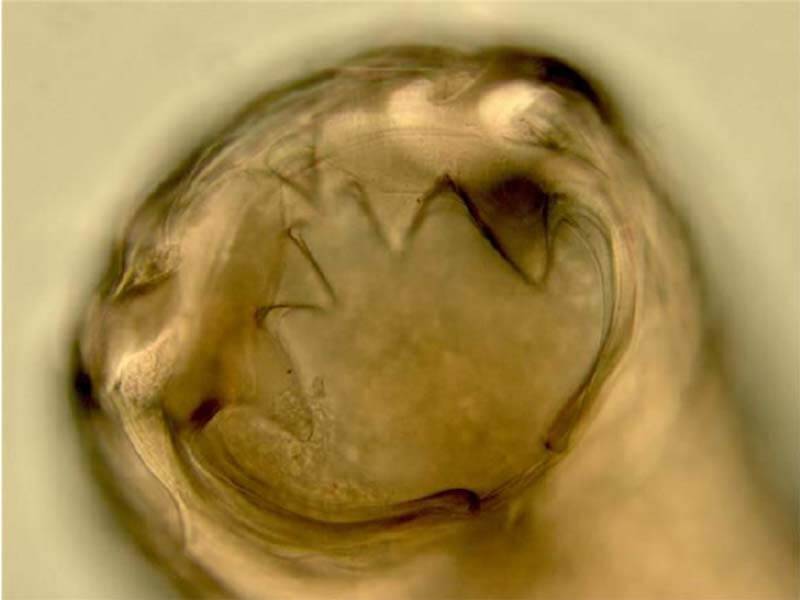
www.researchgate.net
Uncinaria
Causes helminthiasis in cats and dogs. Small nematode: the male reaches 5-8,5 mm, and the female – 7-12 mm.
The oral cavity of the uncinaria is equipped with a pair of plates that do not have teeth. Parasitic in the small intestine. May enter the body through the skin, causing dermatitis.
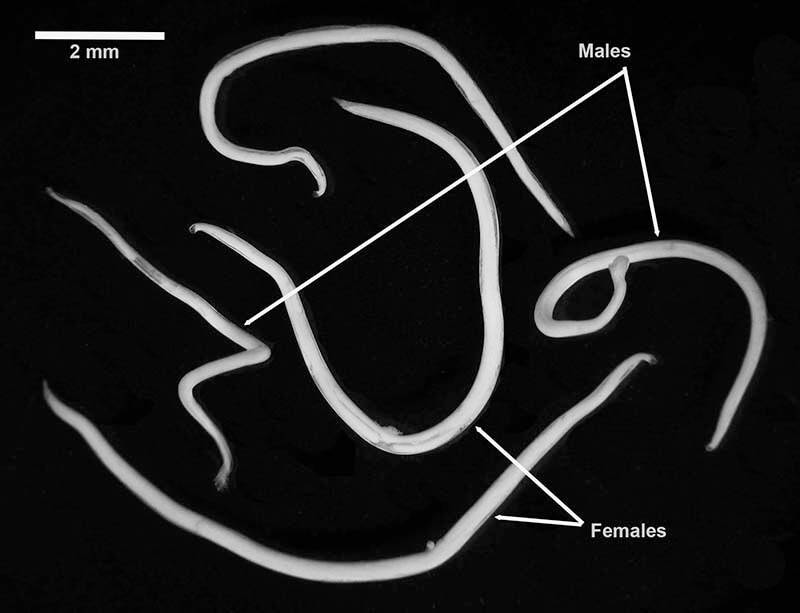
wcvm.usask.ca
Telazia
Telazia parasitizes the surface of the eye mainly in dogs, foxes, bears and other wild animals. Invasion in cats is very rare.
The male usually reaches a length of 7,7-12 mm, the female – 12-18 mm.
The nematode feeds on tears. The disease is carried by flies, from one animal to another.
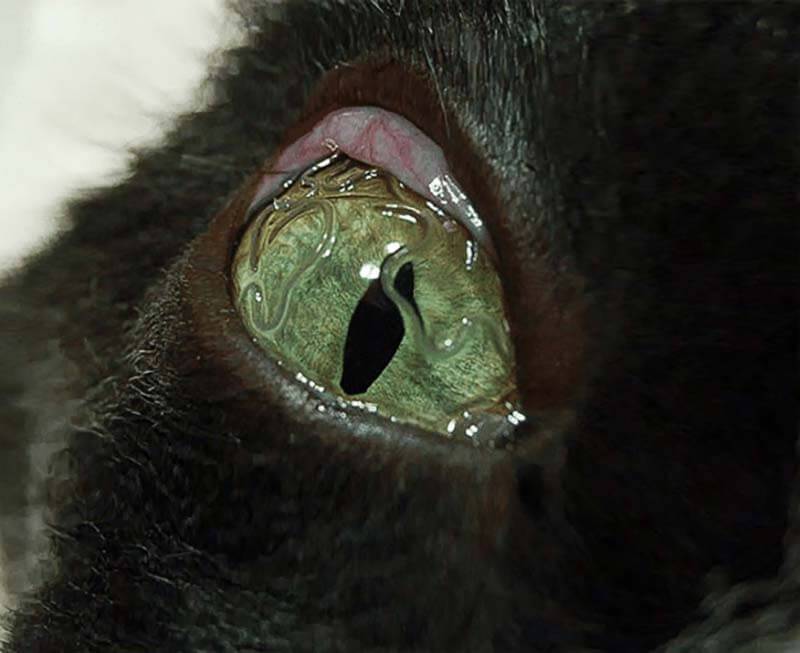
www.researchgate.net
capillary
Worms parasitize cats, dogs and foxes in the respiratory system. The capillary penetrates into the trachea, bronchi, much less often into the nasal cavity and frontal sinuses.
Adult parasites are relatively small, 16–18 mm (males) and 18–20 mm (females) in length.

en.wikipedia.org
Elurostrongylus
Pulmonary worms in cats inhabiting the alveoli and bronchioles. Females are 10–12 mm long, males 5–6 mm.
Pulmonary worms in cats are found throughout the world, but the prevalence of invasion is very low compared with intestinal parasites.
The eggs secreted by the parasites are coughed up and swallowed. They are brought out with faeces, where they mature to the invasive stage using intermediate hosts.

en.wikipedia.org
Heart and subcutaneous worms
Helminths mainly parasitize dogs and other members of the canine family. Rarely infect cats. Found in regions with hot climates.
The body length of female heart dirofilaria reaches 30 cm, the diameter is only about 1 mm. Males grow up to about 18 cm in length.
Parasites inhabit the right side of the heart and the area of the pulmonary artery adjacent to the heart.
Subcutaneous dirofilaria reaches a length of 5-7 cm (males) and 10-17 mm (females). Adult parasitic worms in cats and dogs are found in the subcutaneous tissue.
Dirofilaria (microfilaria) worm larvae in cats circulate in the circulatory system. Infection and spread occurs through mosquito bites.
Worm infestation in cats is easier than in dogs.
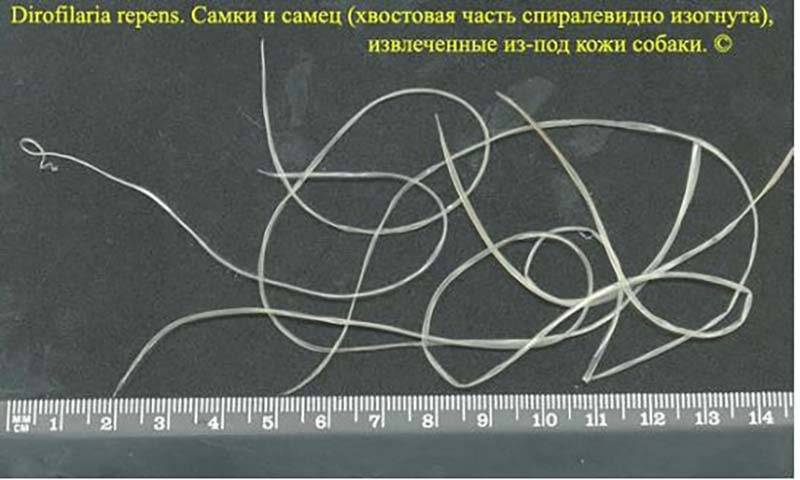
fbuz45.ru
Cestodes – tapeworms in cats
Cause such a disease as cestodosis. Helminths are tape-shaped. In the structure, one can distinguish the head (scolex) with segments (segments) extending from it in the form of a chain. These segments are continuously formed, then alternately come off and are brought out with feces.
On the head of the cestode is a mouth apparatus with hooks or suction cups, with which it clings to the intestinal wall. Tapeworms in cats are hermaphrodites (one individual contains female and male sexual characteristics). There are always two hosts in the development cycle.
Tenioses
The genus Taenia spp. This group of tapeworms includes several varieties.
Helminthiasis in cats can cause the following types:
Taenia pisiformis – about 40–150 cm and Taenia serialis – about 25 cm, the intermediate host is a rabbit and a hare.
Taenia hydatigena – about 50–250 cm, intermediate host – cow, sheep, pig.
taenia taeniaeformis – about 20–60 cm, intermediate host – rodents.
They parasitize in the small intestine. When eating the meat and organs of infected animals, the cat becomes infected.

www.biolib.cz
Cucumber tapeworm in cats
This is a tapeworm (Dipylidium caninum). Parasitic in the small intestine of cats and dogs. Adult helminths reach 80 cm. The segments that come out with feces are whitish, about 3-4 mm long and look like cucumber seeds – hence the name – cucumber tapeworm.
In the development cycle of tapeworm, an intermediate host is needed – a flea. Ingestion of infected fleas infects cats.
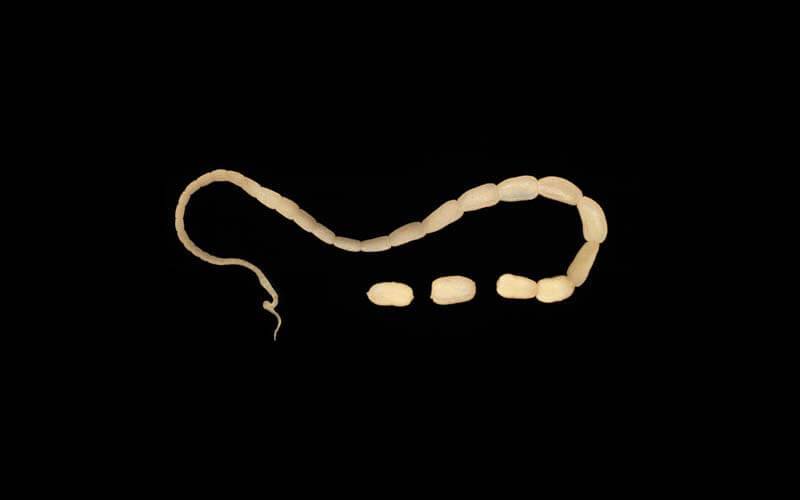
en.wikipedia.org
Alveolar echinococcus
Very small cestode up to 7 mm long. It grows very slowly, and the disease often goes unnoticed. The intermediate host is small rodents. Cats are rarely infected. The main host is the fox.
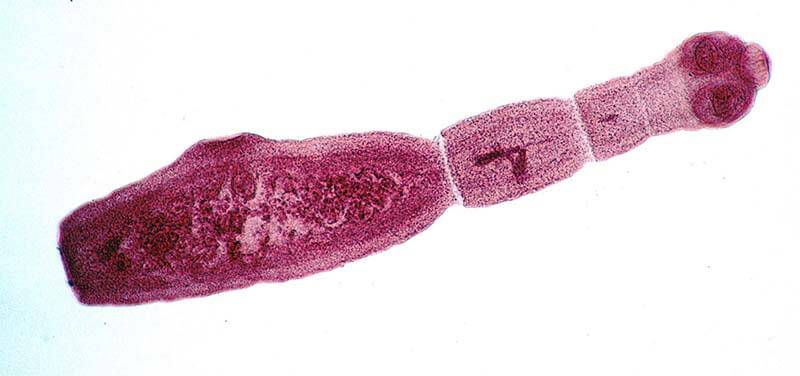
en.wikipedia.org
Trematodes in cats
Trematodes or flukes are flat parasitic worms. They can live in the intestines or in the liver. The development cycle occurs with the participation of the intermediate host. Cats are parasitized by the following types of such helminths.
Alaria
Adults are 2.5-6 x 0.5-2 mm in size. They parasitize in the small intestine of cats and dogs.
They have a very complex development cycle involving several intermediate hosts (small molluscs, tadpoles, reptiles, amphibians, and even wild boars). Cats can become infected by eating the meat of the intermediate host. Wild animals play an important role in the spread of the disease.

wcvm.usask.ca
Double lip
A flatworm that parasitizes in the bile ducts, thereby causing damage to the liver of the bile ducts. The size of the parasites is 1,2–3 x 8–13 mm.
The eggs of the worms with bile reach the intestines and go out with the feces. Once in the aquatic environment, the larvae of the parasite first penetrate into the mollusk, then into the body of the fish. Cats become infected by eating infected fish.
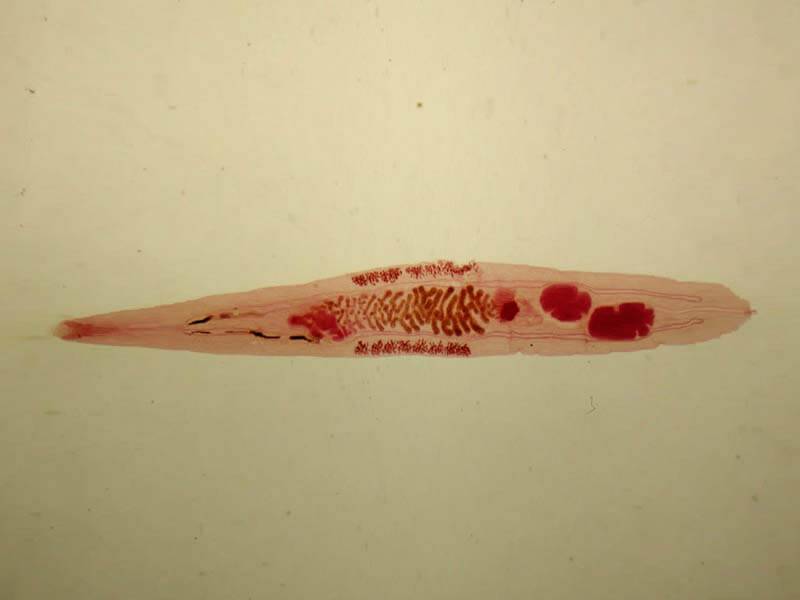
en.wikipedia.org
How does the infection occur?
Ways of infection of the animal directly depend on the cycle of development of the worm. The development cycle is the process of development of a helminth from an egg to a sexually mature individual. He can be:
direct (in the process of development, worms parasitize only one animal).
with the use of an intermediate host (in the process of development they pass from one animal species to another).
Nematodes have a direct development cycle, and with the use of an intermediate host.
The eggs are released into the environment with feces.
In the external environment, in the soil, eggs can be stored for a very long time.
The feline toxocara is also able to use an intermediate host – a mouse or a rat. A rodent, when swallowing helminth eggs, becomes infected, but in the body the larvae do not pass into the sexually mature stage, but go into a dormant state. Toxocara also has another feature – in a pregnant cat, the larvae are excreted with milk.
In hookworms and uncinaria, larvae emerge from eggs in the external environment.
In dirofilariasis (heart and subcutaneous helminths), the cycle of development and transmission of invasion occurs with the participation of mosquitoes. Although it should be noted that this type of helminthiasis in cats is extremely rare.
The development of cestodes and trematodes always occurs with the use of an intermediate host. In the body of a cat, the sexual stage of the life of the helminth passes with the release of eggs into the external environment. In the external environment, animals that are intermediate hosts (fleas, rodents, fish, lagomorphs, etc.) become infected. Infection of cats occurs by eating the intermediate host.
Infection with certain helminths depends on environmental factors:
Some parasitic worms are found mainly in regions with a hot climate (for example, subcutaneous or cardiac dirofilaria).
The presence in the territory where the cat lives, wild and stray animals.
Violation of the hygiene rules for keeping pets: crowding (when there are a lot of cats in the house), untimely cleaning of toilet trays and other care items, lack of preventive treatments for parasites.
Infection of cats occurs when:
Ingestion directly of eggs or larvae from the external environment. Cats often lick their fur and paws. Even cats that never go outside are at risk of infection. Helminth eggs can be brought into an apartment with dirt on street shoes.
Flea infestation.
Eating rodents, frogs, lizards.
Feeding raw meat and fish.
Drinking the milk of an infected mother.
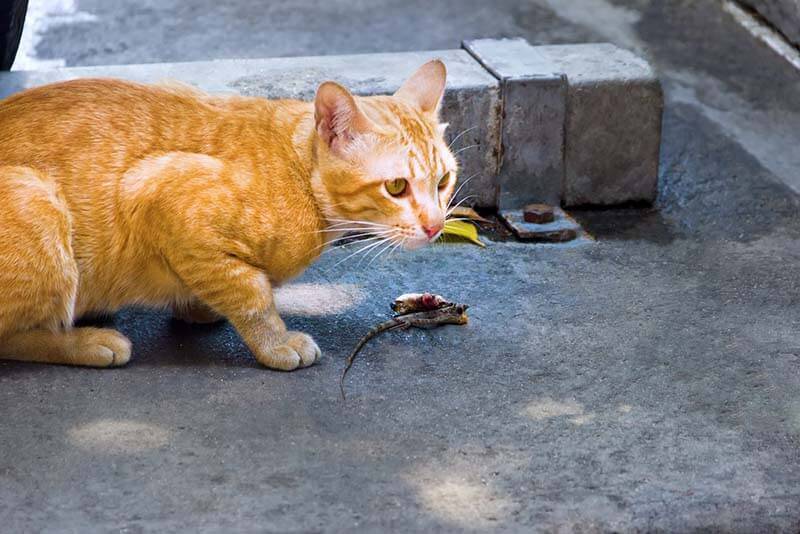
Symptoms of worms in cats
Symptoms of the disease depend on where the worm parasitizes. Most often, helminths are found in the intestines, and can also affect: the liver, trachea, bronchi, lungs and skin.
Being attached in the intestines with the help of hooks and suckers, they injure its mucosa, disrupt the absorption of nutrients into the body. Sometimes with a strong invasion, when there are a lot of parasites, they can cause mechanical intestinal obstruction.
Being in the liver, clog the bile ducts, lead to inflammation and destruction of the liver.
Being in the bronchi and lungs, they cause diseases of the respiratory system, bronchitis, in severe cases – pneumonia.
The severity of symptoms may vary.
Very often, helminthic invasion is asymptomatic. But with a strong infection, when there are a lot of parasites in the body, they cause severe harm to the body, and the symptoms become more pronounced.
They may be the following:
Vomit. Sometimes you can see that the cat is vomiting worms.
Diarrhea, the presence of blood, mucus, and sometimes the helminths themselves in the feces.
Jaundice of mucous membranes and skin.
Enlarged barrel-shaped abdomen.
Deterioration in the quality of wool (dull, dirty).
Cough.
Anemia.
Skin itching, scratching (rare).
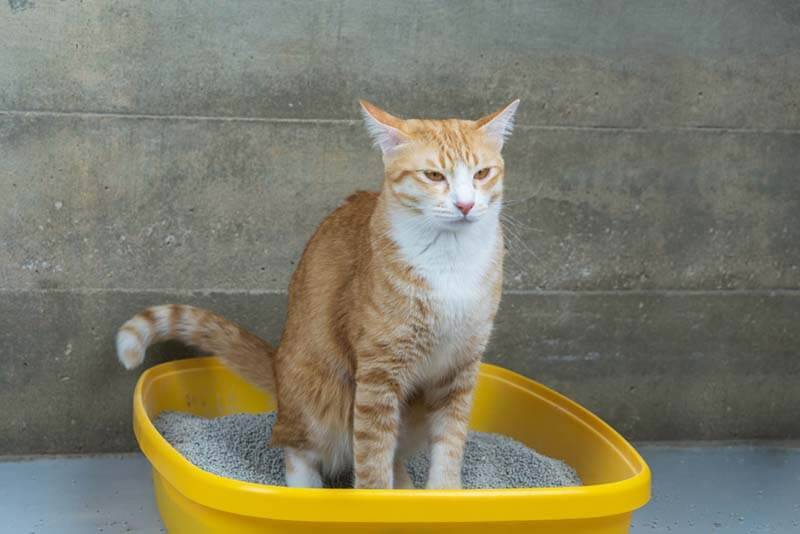
Diagnostics
Considering that almost all eggs of worms go into the external environment with feces, the main diagnostic method is a laboratory study of feces. In the laboratory, after special preparation of feces, helminth eggs are found under a microscope and the type of parasite is determined.
Eggs are shed cyclically and a single examination of feces may not detect helminthic invasion. Therefore, it is recommended to examine several samples.
In dirofilariasis, the larvae are not excreted in the feces, they circulate in the blood and do not enter the intestines. For diagnosis, blood is used to detect larvae – microfilariae.

Treatment of worms in cats
A large number of anthelmintic drugs have been developed for the treatment of nematodes: Pirantel, Mebendazole, Fenbendazole, macrocyclic lactones (Ivermectin, Moxidectin, Selamectin). When treating, it is necessary to take into account the type of helminth and the source of infection. Sometimes one dose of the medicine is enough, sometimes the drug is given according to a certain scheme, and the treatments are repeated at certain intervals (very important when treating kittens).
Praziquantel is used to treat tapeworms. Again, it is worth considering that the source of infection is fleas or eating raw meat.
Praziquantel is also used to treat trematodes. Treatment of trematodosis should be carried out under the supervision of a physician. The drug is prescribed in courses of several days, taking into account the worming of the pet.
Depending on the severity of the clinical signs of the disease, for example, vomiting, diarrhea, jaundice, treatment is carried out in parallel to eliminate these symptoms.
What can you give a cat for worms?
In veterinary pharmacies and pet stores, a large number of deworming products are available for sale. Preparations are for oral use:
In tablets (Milbemak, Milprazon, Drontal, Kanikvantel),
In suspensions (Parazicide, Parasitel, Helmintox),
In the form of drops applied to the skin at the withers (Selafort, Stronghold, Profender).
Most oral preparations are combined and contain several components against roundworms, tapeworms and flatworms.
Drops applied to the withers, as a rule, contain only macrocyclic lactones (stronghold, selafort, lawyer) and act on roundworms, but there are also broad-spectrum drugs (Profender). This point must be taken into account when choosing drops.
The dose of the drug is calculated on the weight of the pet, as a rule, one tablet is suitable for a cat from 2 to 8 kg. For kittens, it is better to choose a suspension, it is easier to dose it for a small weight. If it is difficult for the owner to give the drug by mouth, then it is better to use drops applied to the skin at the withers.
Treatment for worms can be done independently at home.
To remove worms from a cat, you need to: weigh the pet, choose an anthelmintic drug (a tablet suspension or drops on the withers) and deworm it. Tablets and suspensions are given to adult animals on an empty stomach. For drops at the withers, a preliminary diet is not required.
Clinically healthy cats are treated for parasites, that is, with a good appetite, without signs of lethargy. If the pet has reduced appetite, apathy, vomiting, diarrhea or other signs of illness, then in this case it is better not to carry out the treatment, but to consult a doctor for examination or consultation.
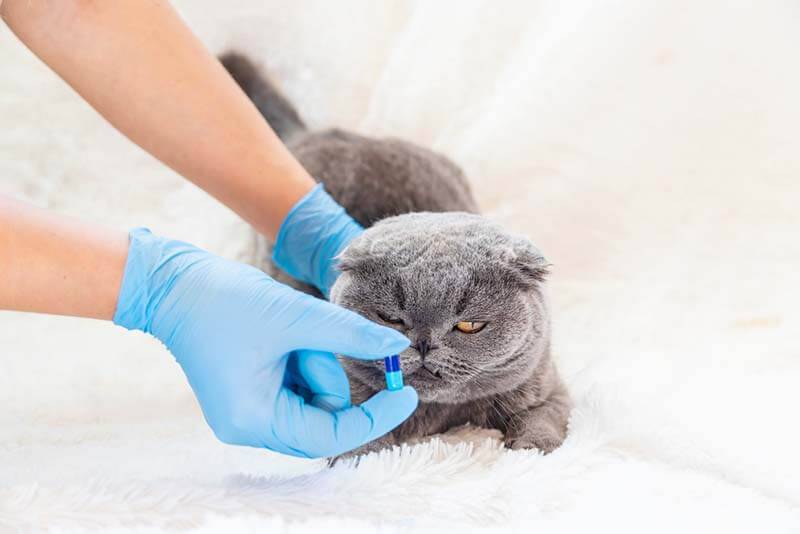
Worms in kittens
The greatest danger to kittens is feline toxocara. If a mother becomes infected with toxocariasis during pregnancy, then the infection of kittens occurs through her milk. Therefore, already at an early, newborn age, kittens have a high level of invasion (very strong worming).
Signs and symptoms of worms in a kitten:
Huge bloated belly, while the ribs are well palpable;
Lagging in growth and development;
Anemia;
Signs of a disease of the respiratory system – cough, shortness of breath.
From worms for kittens, there are specially designed anthelmintic preparations for sale. These are suspensions (Parazitelparazitsid) or drops on the withers (Stronhold / Selafort / Profender for kittens). The treatment is carried out from 6 weeks of age with a kitten weighing more than 500 g.
A starvation diet before deworming is not required. Sometimes treatment for worms in a cat needs to be carried out at an earlier age and with a body weight of less than 500 grams – it is carried out only on the recommendation and under the supervision of a veterinarian.
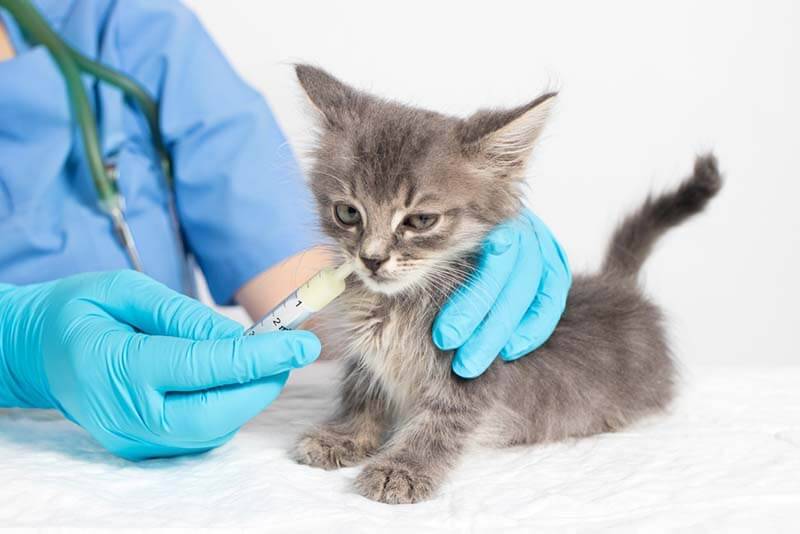
Prevention
Remove raw meat and fish from the cat’s diet.
If possible, exclude the contact of the animal with street shoes, places where they walk in street shoes, and any contact with the external environment.
Preventive treatments for fleas.
Of course, in some cases it is impossible to follow these rules. Many city cats are taken out to the dacha in the summer, and some have free access to the street during the year, where they come into contact with other cats and hunt.
Therefore, for the prevention of worms in cats, treatment with broad-spectrum drugs is recommended:
For cats who never go outside and do not eat raw meat and raw fish – 1 time in 6 months.
For cats going outside, receiving raw meat or fish with food – 1 time in 3 months.
Extra charges:
Treatment of pregnant cats to prevent infection of kittens – 10 days before birth.
Treatment of kittens 1 time per month until they reach 6 months of age.
When attending mass events (exhibitions, competitions), processing is required before the event and re-processing 2-4 weeks after.
For nurseries and shelters, deworming is recommended once a month or monthly parasitological examination of faeces and treatment depending on the results.
At home, where there are children under 5 years of age and people with a weakened immune system, treatments once a month or monthly parasitological examination of feces and treatments depending on the results.
In case of flea infestation, deworming once, together with flea treatment.
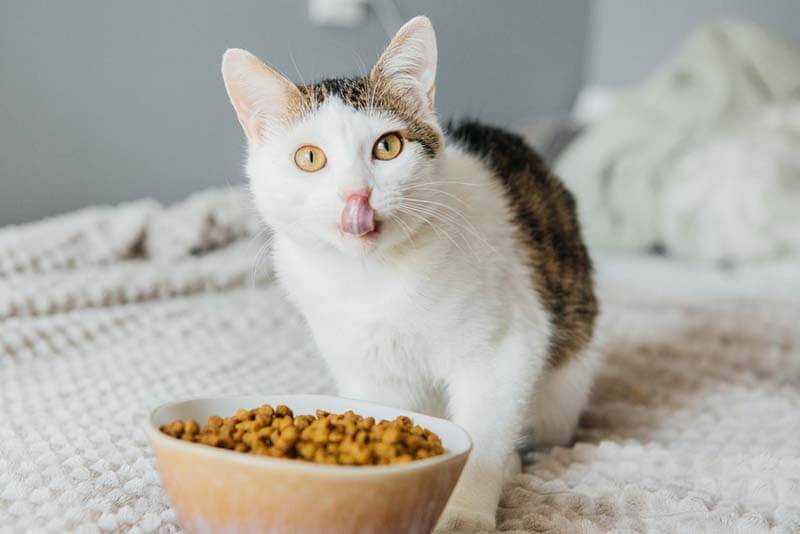
Can you get worms from a cat?
Many helminths that parasitize cats can be transmitted to humans. Humans can become infected by accidentally ingesting eggs from the environment. Or in the case of the cucumber tapeworm, if a flea is accidentally swallowed.
Cat parasites are especially dangerous for young children.
The disease in humans proceeds differently than in cats. Helminths in the body in humans do not develop to the sexual stage, and after a while they leave the body or go into a dormant state. Despite this, personal safety rules must be observed: when cleaning feces, use protective gloves, thoroughly wash vegetables from the beds and hands before eating, and treat your pets with regular deworming.
Helminths in Cats: Essentials
In cats, there are different types of parasites that affect the intestines, the respiratory and circulatory system, and the skin.
Toxocariasis is most dangerous for small kittens.
Infection of cats can occur by swallowing helminth eggs from the external environment, by infecting with fleas, eating raw meat and fish, mice, frogs and lizards.
Infection with worms is often asymptomatic or with mild symptoms.
Worm infestation in cats is dangerous to humans.
It is necessary to regularly carry out preventive treatments for worms.
Answers to frequently asked questions
Sources:
“Parasitic diseases of cats and dogs in Russia” Maggie Fisher, LenaingAlos, Sergey Konyav 2015
Helminths in veterinary practice Small animal parasitology guide for veterinary clinics Stefan Paknike, Dorothy Stannek, Norbert Menke © Bayer HealthCare Deutschland, Animal Health, Leverkusen, 2015
Clinical Parasitology of Dogs and Cats Authors: MVDr. Vlasta Svobodova, CSc. Doc. MVDr. Miroslav Svoboda, CSc. Brno 1995



